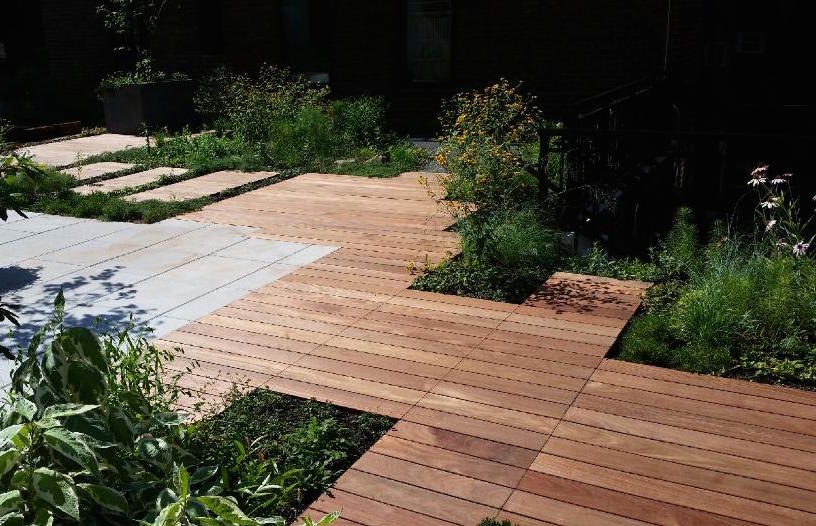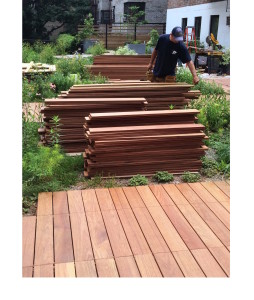 Sustainable Manchiche Decking at Simbiótica Living Roof
Sustainable Manchiche Decking at Simbiótica Living Roof

Deforestation is a primary cause of climate change and biodiversity loss. Consequently, there is a need for landscape designers, architects and other design practitioners who specify building materials derived from forest biomes, such as wood, to adopt sustainable alternatives that both reduce environmental harm along their supply chains and perform as well as or better than their conventional analogs.
For the decking material of our Simbiótica Living Roof, with its contemporary armature of timber bridges and boardwalks, we turned to a pioneering program launched by the Wildlife Conservation Society and Pilot Projects Design Collective. The enterprise is based out of the small village of Uaxactún, Guatemala (population: 750) located at the heart of the Maya Biosphere Reserve, the largest and one of the most biologically diverse rainforests in all of Central America.  Using a novel approach to tropical forest conservation that incorporates selective tree harvesting as part of the solution, this endeavor links the technical resources of conservation planners with the traditional ecological knowledge of native residents, in an effort that simultaneously sustains a local community and a globally significant rainforest ecosystem.
Using a novel approach to tropical forest conservation that incorporates selective tree harvesting as part of the solution, this endeavor links the technical resources of conservation planners with the traditional ecological knowledge of native residents, in an effort that simultaneously sustains a local community and a globally significant rainforest ecosystem.
The Uaxactún Community Forest, as it is known, spans over 200,000 acres and operates by government concession. Two-thirds of this land is dedicated strictly to habitat preservation, while the remaining one-third is utilized for reduced-impact logging. To ensure that all timber extraction is innocuous to the forest ecosystem, renewable harvesting limits are strictly adhered to, such as a 40-year cutting cycle and strategic tree felling. The proceeds from lumber sales offer the Uaxactún community the means to protect its reserve area from poaching and deforestation and invest in educational programs for its inhabitants. In addition to its sustainable life cycle, the hardwood species, known as manchiche or “Mayan mahogany,” was also integrated into Simbiótica Living Roof because of its natural properties of high durability, density, and rot resistance.
The benefits of the 40-year cutting cycle are twofold: it is good for the environment and good for the end client. As a single mature or ancient tree is felled from any given acre, and all other trees in that area are left intact for 40 years thereafter, medium-sized specimens have ample time to grow and fill the role of the previously harvested fully grown trees. By allowing the trees to go through their natural process of growth and reach their end stages of life, these mature specimens will contain higher proportions of the hardest tissue, known as protection wood or static mass. By employing this surgical approach to harvesting in the Uaxactún Community Forest, not only does the forest regenerate itself, but the customer also receives lumber with the extraordinary properties and quality of old-growth hardwood.
 This innovative conservation venture really is an exemplar for those seeking to take crucial steps forward to a sustainable future. We here at CDL/S are thankful for the opportunity, made possible through the laudable efforts of the Wildlife Conservation Society and Pilot Projects Design Collective, to leverage our platform, as designers, to positively impact a community and rainforest abroad. As one of New York City’s first-ever installations of Uaxactún manchiche (along with the New York Aquarium’s state-of-the-art shark exhibit now being constructed), Simbiótica Living Roof is proud to serve as a pilot for a much larger project being proposed to the City for the next cycle of hardwood deck replacement at the Brooklyn Bridge promenade, dubbed the Brooklyn Bridge Forest.
This innovative conservation venture really is an exemplar for those seeking to take crucial steps forward to a sustainable future. We here at CDL/S are thankful for the opportunity, made possible through the laudable efforts of the Wildlife Conservation Society and Pilot Projects Design Collective, to leverage our platform, as designers, to positively impact a community and rainforest abroad. As one of New York City’s first-ever installations of Uaxactún manchiche (along with the New York Aquarium’s state-of-the-art shark exhibit now being constructed), Simbiótica Living Roof is proud to serve as a pilot for a much larger project being proposed to the City for the next cycle of hardwood deck replacement at the Brooklyn Bridge promenade, dubbed the Brooklyn Bridge Forest.
For more information, we invite you to watch this short video below of Dr. Jeremy Radachowsky, Director of Mesoamerica and Western Caribbean at the Wildlife Conservation Society, speaking on site at Simbiótica Living Roof. The talk offers remarkable insight into the details behind the proposal to re-plank the Brooklyn Bridge promenade, how this tropical manchiche wood is carefully sourced and milled, and the ecological and social benefits of supporting community-managed forests, such as the Uaxactún Community Forest.

